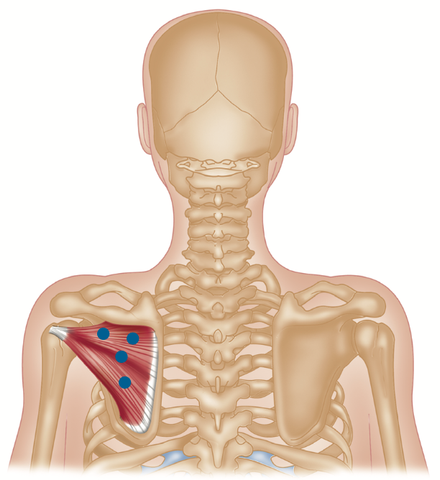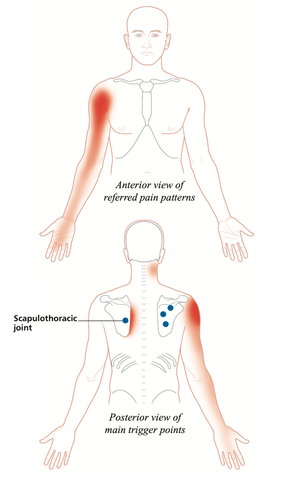Shoulder Pain and Stiffness - Treating Infraspinatus

The infraspinatus muscle is an important part of the rotator cuff. It helps stabilize the shoulder joint by acting against the deltoid muscle and the teres minor muscles. However, this muscle can be overused or weak, which can cause shoulder impingement. If you are experiencing pain in your shoulder, you should consult a doctor. He or she can determine what is causing the pain and offer treatment. This can include medication, conservative therapies including natural alternative therapies and exercises to strengthen the muscles.
The infraspinatus is one of the four muscles that make up the rotator cuff. These muscles prevent the humerus from dislocating. They also help stabilize the head of the humerus in the glenoid cavity. When the muscle is overused, it can lead to a tear of the tendon or a bursitis. Symptoms can include pain, swelling, and loss of range of motion. In some cases, surgery may be necessary to correct an infraspinatus tear.
Infraspinatus muscle trigger points are characterized by intense pain in the front or back of the shoulder. This pain can be caused by many different factors, such as trauma or poor posture. There are several ways to relieve the pain, including acupuncture and dry needling. Depending on your condition, a doctor, physiotherapist or other suitable qualified professional can recommend therapies, exercise, heat, or ice to reduce the symptoms.
Trigger point acupuncture can be an effective way to release the infraspinatus muscle and improve your movement. In addition, it may help reduce muscle soreness during workouts. Dry needling works by eliciting a twitch response in the muscle, which relaxes it and decreases pain. Performing stretches on the shoulder can also help to strengthen the infraspinatus and will often be prescribed together with trigger point therapy.
Infraspinatus is a thick triangular muscle located on the dorsal surface of the scapula. The muscle originates from the infraspinous fossa below the scapula. After forming, the fibers of the infraspinatus converge into a narrow tendon that crosses the posterior side of the shoulder. A normal stride pattern involves the shoulder retracting backwards and flexing up. The infraspinatus tendon then inserts onto the middle impression of the greater tubercle of the humerus.
Infraspinatus muscles can be overworked during high-energy activities, such as running. To prevent this from happening, it is important to take regular breaks from activity. You can also ask a physiotherapist or fitness professional to advise on stretches for your infraspinatus that may help to prevent injury.
Muscle Energy Stretching Technique - Infraspinatus
The infraspinatus muscle is member of the rotator cuff group, which comprises the supraspinatus, infraspinatus, teres minor, and subscapularis.

Origin
Infraspinous fossa of scapula.
Insertion
Middle facet on greater tubercle of humerus. Capsule of shoulder joint.
Action
As a rotator cuff muscle, helps prevent posterior dislocation of shoulder joint. Laterally rotates humerus.
Antagonists: subscapularis, pectoralis major, latissimus dorsi.
Nerve
Suprascapular nerve, C(4), 5, 6, from upper trunk of brachial plexus.
Basic Functional Movement
Example: brushing hair back.
Referred Pain Patterns
Middle/upper cervical spine: deep anterior shoulder joint zone of
3–4 cm in region of long head of biceps brachii, radiating into biceps belly then into forearm—diffuse symptoms in median nerve distribution.
Medial/scapula: to medial border of scapula.

Indications
Decreased range of motion in Apley scratch test (behind back), hemiplegia, rotator cuff tendinopathy, frozen shoulder syndrome, pain in back and front of shoulder, night-time shoulder pain when sleeping on same/ opposite side, dead-arm sensations, pain undoing bra, shoulder girdle fatigue, weakness of grip, loss of arm strength, changes in sweating (usually increased), “mouse arm” from computer mouse overuse.
Causes
Overuse activities with arm unsupported (e.g. computer mouse, driving, tennis, weight training, water sports, ski poles), pulling objects behind body, sudden trauma from fall on outstretched arm/ catching yourself when trying to stop a fall, prolonged holding of heavy objects.
Differential Diagnosis
Biceps tendonitis. C5–C6 neuropathy. Suprascapular nerve dysfunction.
Connections
Infraspinatus, subscapularis, levator scapulae, pectoralis minor/major, long head biceps brachii, biceps brachii, anterior deltoid, teres major, latissimus dorsi, rotator cuff issues, biceps tendonitis.
Massage Therapy For Rotator Cuff Injuries
Rotator cuff injuries can be painful and prevent you from being able to carry out everyday activities. Massage therapy may be a great way to relieve pain, increase mobility, and regain your strength.
Massage can be used as part of a recovery program after surgery, or it can be used to help you get back to work or play. Your doctor or physical therapist can advise you on what types of massage therapy are best for your injury.
Rotator cuff injuries can be caused by a number of factors. You may have overused the muscle or damaged it. This can be painful, but with the right care, the damage can be minimized.
If your rotator cuff has been badly injured, the first thing you should do is contact a medical professional. They can tell you whether surgery or other medical intervention is needed. Physicians will often recommend other forms of conservative treatment. This may include referrals to a number of different types of natural alternative therapies such as massage, acupuncture, trigger point therapy, osteopathy, chiropractic manipulation and more traditional physical therapy. Most mild rotator cuff injuries are treated with a combination of massage, over-the-counter pain relievers or anti-inflammatory drugs where prescribed), heat, ice and rest.
Once you have made the decision to see a massage professional, it is important to get a detailed evaluation of your condition. You may also wish to follow up with a physical therapist who can help determine if your injury is caused by a muscle or tendon issue, and can prescribe exercises to help you heal. Including massage in your treatment plan can help more or less depending on the type of injury but also depending on the skill and experience of your massage therapist. So make sure to do your research and choose carefully.
If your injury is correctly diagnosed and not too serious, you might be surprised at how quickly a good massage therapist can get your shoulder moving again!
Cupping For Rotator Cuff Injuries
Rotator cuff injuries are among the most common causes of disability. They can be a result of overuse or trauma. With proper care, they often improve, although they may not go away entirely. In severe cases, surgery may be necessary.
Cupping is a nonsurgical treatment option for rotator cuff injuries. This therapy involves the use of cups to create suction on the skin. It can break up scar tissue, reduce swelling, and help with pain.
Cupping is usually performed by a physical or manual therapist, though it can be also be safely done at home. Many people consider cupping to be a form of massage. However, the cupping process is often described as a stretching and mobilization therapy.
Cupping therapy generally works to increase blood flow to the body tissues, reducing inflammation and stiffness. Additionally, it can break up micro-adhesions in muscle fibres and fascia.
Cupping is often a divisive issue with many authorities citing the lack of evidence for the therapy. On the other hand there is a growing body of research and anecdotal evidence from treatment rooms at the highest levels of elite sports and athletics. These include recent research studies of collegiate baseball pitchers treated with cupping therapy who reported a reduction in pain and increased range of motion. The study also noted that the recipients of cupping in this study didn't suffer any swelling after treatment.
If your therapist or trainer recommends cupping you shouldn't have any reason to fear giving it a go. As always, do your research to ensure you are receiving treatment from a qualified and suitably experienced professional. In addition to physical therapists who have adopted cupping, you will find that many professional massage therapists are trained and experienced in the use of cups.
Acupuncture For Rotator Cuff Injuries
Acupuncture for rotator cuff injuries is a safe, noninvasive approach to treatment. When used in conjunction with other treatments, it can be effective in relieving pain and improving function of the affected muscles.
It may also help relieve inflammation and restore blood flow to the shoulder. This can speed up healing. As part of a treatment plan, acupuncture may be combined with Chinese cupping techniques, massage and exercises.
Rotator cuff tears are a common overuse injury. In addition to pain and restricted blood flow, patients may experience weakness. However, acupuncture may help heal tears and restore normal range of motion.
While many doctors prefer conventional treatment approaches, including cortisone injections, acupuncture may often be a viable alternative for rotator cuff injuries. Although the mechanisms of acupuncture for rotator cuff injuries are not completely understood there are in fact some studies (albeit minor scope) that support using a combination of acupuncture and manual therapy to reduce pain and improve shoulder function.
A suitably qualified acupuncture practitioner may be able to help evaluate the strength, range of motion and stability of the shoulder. Once a plan for treatment is developed, needles are inserted into trigger points to release knots, relax muscle, increase blood flow, and promote the release of natural anti-inflammatory agents.
Generally acupuncture is considered a safe and sometimes very effective natural alternative therapy. Be sure however never to let anyone treat you with needles unless you are certain that they are suitable qualified, certified and lisenced to do so!

Continuing Professional Education
Looking for Massage Therapy CEUs, PT and ATC continuing education, chiropractic CE, or advanced manual therapy training? Explore our evidence-based online courses designed for hands-on professionals.


















